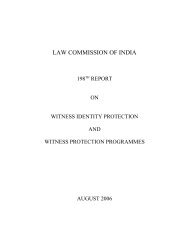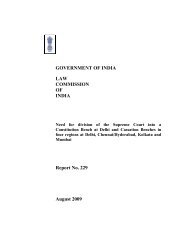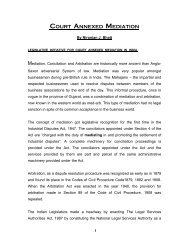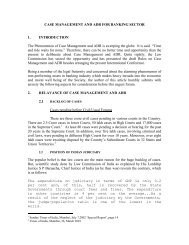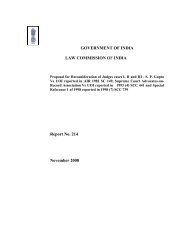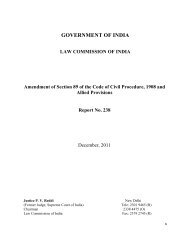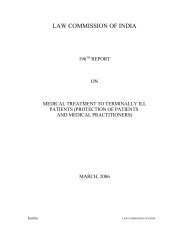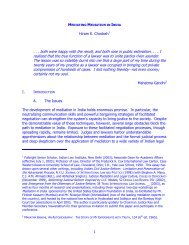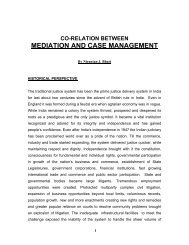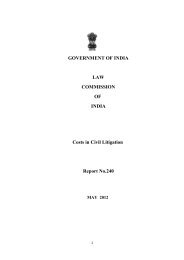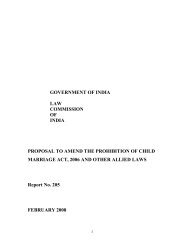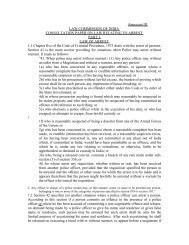217th Report on Irretrievable Breakdown of Marriage - Law ...
217th Report on Irretrievable Breakdown of Marriage - Law ...
217th Report on Irretrievable Breakdown of Marriage - Law ...
Create successful ePaper yourself
Turn your PDF publications into a flip-book with our unique Google optimized e-Paper software.
2.11 In Samar Ghosh vs Jaya Ghosh 23 the Supreme Court referredto the 71 st <str<strong>on</strong>g>Report</str<strong>on</strong>g> <strong>of</strong> the <strong>Law</strong> Commissi<strong>on</strong> <strong>of</strong> India <strong>on</strong> "<strong>Irretrievable</strong><strong>Breakdown</strong> <strong>of</strong> <strong>Marriage</strong>" with approval as follows:“90. We have examined and referred to the cases from the variouscountries. We find str<strong>on</strong>g basic similarity in adjudicati<strong>on</strong> <strong>of</strong> casesrelating to mental cruelty in matrim<strong>on</strong>ial matters. Now, we deem itappropriate to deal with the 71st <str<strong>on</strong>g>Report</str<strong>on</strong>g> <strong>of</strong> the <strong>Law</strong> Commissi<strong>on</strong> <strong>of</strong>India <strong>on</strong> "<strong>Irretrievable</strong> <strong>Breakdown</strong> <strong>of</strong> <strong>Marriage</strong>".91. The 71 st <str<strong>on</strong>g>Report</str<strong>on</strong>g> <strong>of</strong> the <strong>Law</strong> Commissi<strong>on</strong> <strong>of</strong> India briefly dealt withthe c<strong>on</strong>cept <strong>of</strong> irretrievable breakdown <strong>of</strong> marriage. This <str<strong>on</strong>g>Report</str<strong>on</strong>g> wassubmitted to the Government <strong>on</strong> 7th April, 1978. In this <str<strong>on</strong>g>Report</str<strong>on</strong>g>, it ismenti<strong>on</strong>ed that during last 20 years or so, and now it would be around50 years, a very important questi<strong>on</strong> has engaged the attenti<strong>on</strong> <strong>of</strong>lawyers, social scientists and men <strong>of</strong> affairs, should the grant <strong>of</strong>divorce be based <strong>on</strong> the fault <strong>of</strong> the party, or should it be based <strong>on</strong> thebreakdown <strong>of</strong> the marriage? The former is known as the matrim<strong>on</strong>ial<strong>of</strong>fence theory or fault theory. The latter has come to be known as thebreakdown theory. It would be relevant to recapitulaterecommendati<strong>on</strong> <strong>of</strong> the said <str<strong>on</strong>g>Report</str<strong>on</strong>g>.92. In the <str<strong>on</strong>g>Report</str<strong>on</strong>g>, it is menti<strong>on</strong>ed that the germ <strong>of</strong> the breakdowntheory, so far as Comm<strong>on</strong>wealth countries are c<strong>on</strong>cerned, may befound in the legislative and judicial developments during a muchearlier period. The (New Zealand) Divorce and Matrim<strong>on</strong>ial CausesAmendment Act, 1920, included for the first time the provisi<strong>on</strong> that aseparati<strong>on</strong> agreement for three years or more was a ground formaking a petiti<strong>on</strong> to the court for divorce and the court was given adiscreti<strong>on</strong> (without guidelines) whether to grant the divorce or not.The discreti<strong>on</strong> c<strong>on</strong>ferred by this statute was exercised in a caseLodder v. Lodder (1921 New Zealand <strong>Law</strong> <str<strong>on</strong>g>Report</str<strong>on</strong>g>s 786). Salm<strong>on</strong>d J.,in a passage which has now become classic, enunciated thebreakdown principle in these words:23(2007) 4 SCC 511.20



